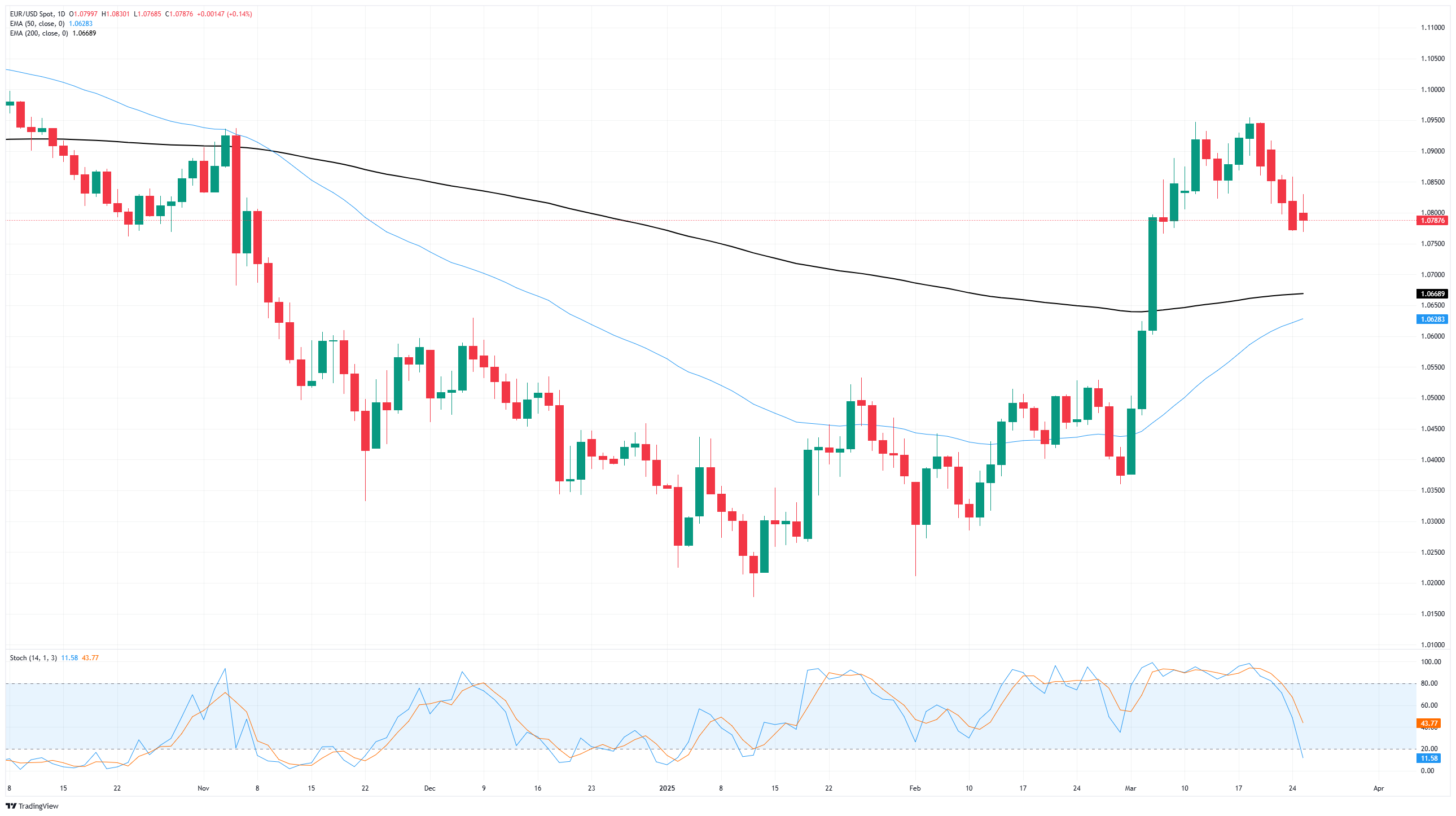EUR/USD continues to backslide, but short pressure beginning to ease
- EUR/USD marked in a fifth straight down day on Tuesday.
- Market headlines take US data misfire in stride.
- US Durable Goods Orders due on Wednesday as Euro traders left to wait.
EUR/USD has slowed its recent pace of declines, but still lost ground for a fifth consecutive trading day as price action continues to test below 1.0800. The Euro is struggling to find its feet as a notable lack of meaningful EU data on the economic docket leaves Fiber bidders at the mercy of geopolitical headlines and market flows from US data releases.
On Tuesday, the US Conference Board (CB) reported an increase in one-year consumer inflation expectations, rising to 6.2% in March from 5.8% in February. Consumers remain highly concerned about the persistently high prices of essential household items, particularly eggs, and the potential inflationary impacts of tariffs imposed during the Trump administration. Furthermore, the CB’s consumer confidence survey revealed a drop in future economic expectations, plummeting to a new 12-year low of 65.2 in March, significantly below the 80.0 mark that typically signals a possible recession.
Adding to these concerns, Moody’s ratings agency issued a strong warning early Tuesday, highlighting a “deterioration” in the US’s fiscal strength, particularly regarding the increasing challenges of servicing US debt. Moody’s also projected that the country’s fiscal strength is likely to face a prolonged decline, a statement likely to anger Donald Trump and his administration, who are currently advocating for a substantial increase in the debt ceiling from Congress.
In US economic news, Durable Goods Orders are set to be released during the New York market session. Overall, these orders are anticipated to decrease by -1.0% in February, following a solid rebound of 3.2% in January.
EUR/USD price forecast
A steady five-day drop has pushed EUR/USD back below the 1.0800 handle, and the pair could be poised for a furthe backslide into the 200-day Exponential Moving Average (EMA) near 1.0675. A near-term turnaround has dragged Fiber back down after a bullish push to the 1.0950 technical level fizzled out, and EUR/USD now has a fresh technical ceiling to contend with if bidders are able to get their ship keel-side down once more.
EUR/USD daily chart
Euro FAQs
The Euro is the currency for the 19 European Union countries that belong to the Eurozone. It is the second most heavily traded currency in the world behind the US Dollar. In 2022, it accounted for 31% of all foreign exchange transactions, with an average daily turnover of over $2.2 trillion a day. EUR/USD is the most heavily traded currency pair in the world, accounting for an estimated 30% off all transactions, followed by EUR/JPY (4%), EUR/GBP (3%) and EUR/AUD (2%).
The European Central Bank (ECB) in Frankfurt, Germany, is the reserve bank for the Eurozone. The ECB sets interest rates and manages monetary policy. The ECB’s primary mandate is to maintain price stability, which means either controlling inflation or stimulating growth. Its primary tool is the raising or lowering of interest rates. Relatively high interest rates – or the expectation of higher rates – will usually benefit the Euro and vice versa. The ECB Governing Council makes monetary policy decisions at meetings held eight times a year. Decisions are made by heads of the Eurozone national banks and six permanent members, including the President of the ECB, Christine Lagarde.
Eurozone inflation data, measured by the Harmonized Index of Consumer Prices (HICP), is an important econometric for the Euro. If inflation rises more than expected, especially if above the ECB’s 2% target, it obliges the ECB to raise interest rates to bring it back under control. Relatively high interest rates compared to its counterparts will usually benefit the Euro, as it makes the region more attractive as a place for global investors to park their money.
Data releases gauge the health of the economy and can impact on the Euro. Indicators such as GDP, Manufacturing and Services PMIs, employment, and consumer sentiment surveys can all influence the direction of the single currency. A strong economy is good for the Euro. Not only does it attract more foreign investment but it may encourage the ECB to put up interest rates, which will directly strengthen the Euro. Otherwise, if economic data is weak, the Euro is likely to fall. Economic data for the four largest economies in the euro area (Germany, France, Italy and Spain) are especially significant, as they account for 75% of the Eurozone’s economy.
Another significant data release for the Euro is the Trade Balance. This indicator measures the difference between what a country earns from its exports and what it spends on imports over a given period. If a country produces highly sought after exports then its currency will gain in value purely from the extra demand created from foreign buyers seeking to purchase these goods. Therefore, a positive net Trade Balance strengthens a currency and vice versa for a negative balance.


